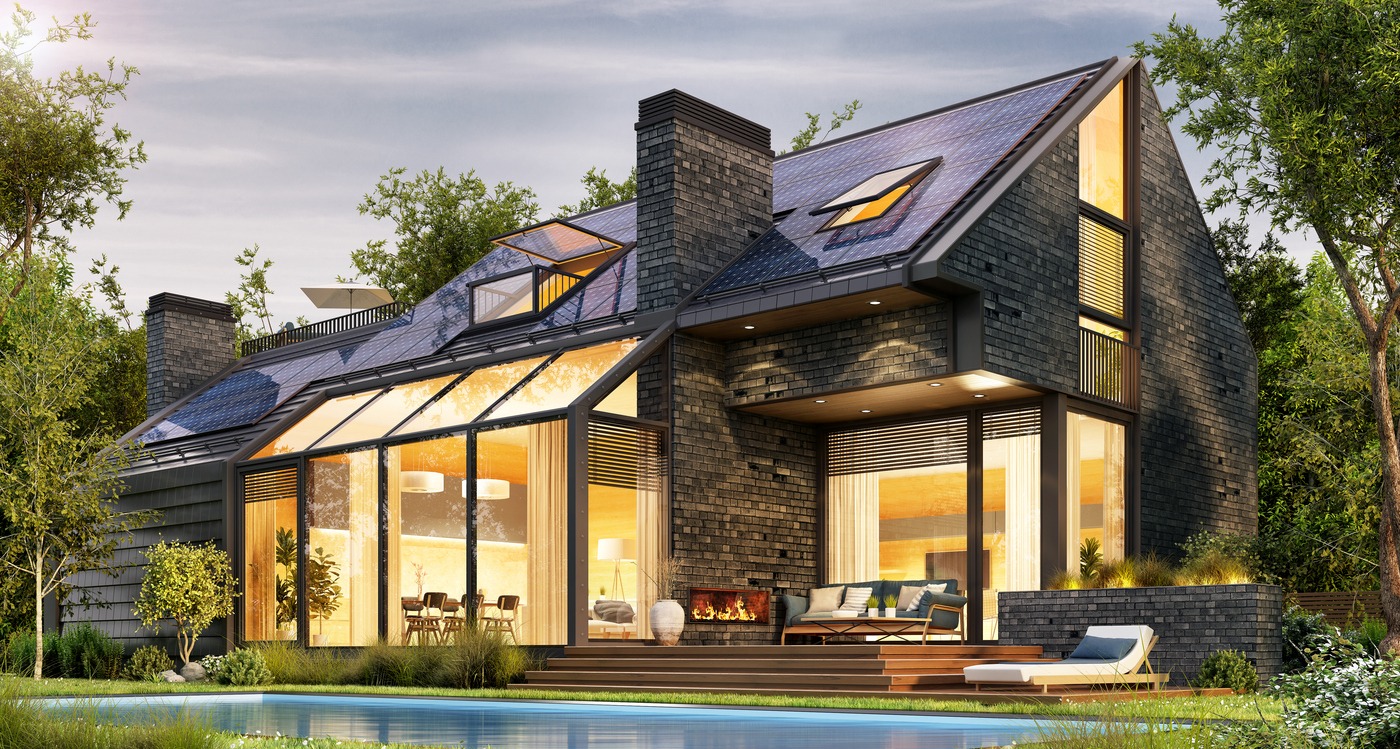Sustainable architecture is transforming the way we inhabit and experience built environments. Architects, designers and artists increasingly incorporate renewable energy to create functional and environmentally responsible buildings. Solar-powered architecture lets buildings generate their own energy without compromising on aesthetics.
In the luxury segment, eco-luxury homes show sustainability and elegance can coexist seamlessly. Through thoughtful material choice, innovative energy solutions and integrated design, renewable energy is becoming a defining feature of sophisticated, forward-thinking residences.
Blending Solar Energy with Design
Building-Integrated Photovoltaics (BIPV) are becoming increasingly popular as the need for Net Zero Energy Buildings (NZEB) rises and designers emphasize visual attractiveness. How BIPVs look matters as much as how they work, influencing both architects and homeowners.
BIPVs use color, shape, texture, balance, rhythm and proportion to fit seamlessly into a building’s design. This lets them produce energy without compromising the structure’s style. The goal is to make solar technology practical and visually appealing, transforming energy solutions into key design features.
By considering aesthetics from the beginning, architects ensure eco-luxury homes are energy-efficient and beautiful. Careful design matters just as much as sustainable performance.
Artistic Solar Panels for Homes
Solar technology is moving beyond traditional panels. Architects now use transparent and colored solar cells in facades, windows and shading systems. These cells produce electricity while enhancing the building’s overall look.
Innovations — like organic solar cells (OSCs) — offer flexible, colorful and semi-transparent options. These can blend seamlessly into a building’s design, giving architects more creative freedom. Semi-transparent OSCs even allow visible light to pass through while capturing energy, making solar panels both practical and decorative.
This approach gives architects and homeowners more flexibility, allowing solar panels to serve as efficient energy sources and attractive design features. By combining practicality with style, solar-powered architecture combines sustainability and sophistication in eco-luxury homes.
Innovative Solar Technology Shaping Architecture
Buildings account for over a third of global electricity consumption, prompting advancements in renewable energy within the architecture sector. OSCs — particularly semi-transparent variants — offer flexibility, color options and transparency, letting architects add solar energy without compromising design.
These panels turn building exteriors into visually appealing energy-generating features, merging sustainability with style. Advances in materials and design now allow energy production to go hand in hand with visual appeal, making solar panels a standout element in luxury homes.
Portable solar generators and light towers make clean energy more accessible, providing eco-friendly options for power outages or daily use. Position them in areas that receive maximum sunlight exposure, which can provide adequate charge for extended illumination when it’s dark.
Meeting Luxury Expectations Sustainably
Experts predict that solar and wind energy could supply 96% of green electricity by 2028, yet many buyers worry that eco-friendly choices might compromise quality, design or comfort. Solar-powered architecture provides a practical solution, enabling designers to integrate renewable energy seamlessly. It preserves elegance and craftsmanship throughout the project.
Eco-luxury homes show energy efficiency and stunning design can coexist. Integrating advanced green technologies allows these residences to meet environmental goals without sacrificing beauty or livability. From carefully placed solar panels to smart appliances and energy-efficient windows, every feature can enhance sustainability and style.
Eco-friendly elements don’t reduce value or comfort. Instead, they add thoughtful innovation, showing that luxury and sustainability can complement each other seamlessly. Grid-tied solar systems and portable solar generators boost reliability and convenience for homeowners. They help reduce carbon footprints, lower energy costs over time and can even increase resale value.
Luxury Real Estate Embracing Sustainability
Buyers who value exclusivity, top-tier amenities and lifestyle-focused features increasingly shape the global luxury residential market. Sustainability and innovative technologies now play a key role in high-end real estate. Affluent homeowners seek elegance while maintaining environmental responsibility.
Smart home systems, energy-efficient solutions and integrated solar technology now enhance traditional luxury features. These include wellness centers, concierge services and state-of-the-art entertainment spaces.
Eco-luxury is gaining momentum, influencing both established cities and emerging markets. Homebuyers seek residences that combine sophistication, comfort and a commitment to sustainability, proving that green living can be essential to a luxurious lifestyle.
Case Study 1 — Musubi House
Musubi House is a prime example of renewable energy in architecture. Designed by Craig Steely Architecture, it sits on 100 acres of grassland and Ohia forest on Hawaii’s Big Island. This 2,200 ft² concrete home is completely off the grid. Photovoltaic panels supply all its energy, while rainfall is collected and stored in cisterns for domestic use and landscaping. Inspired by the Japanese rice snack musubi, its triangular plan seems to float within the rolling grasslands.
The sharp prow of the home deflects strong trade winds, while a central atrium creates a seamless connection between indoor and outdoor spaces. Floor-to-ceiling glass walls blur the line between the house and the surrounding landscape.
Strategically placed ferns and palms provide privacy without blocking the views. Musubi House is a striking example of how eco-luxury design can seamlessly blend sustainability, elegance and a profound connection to nature.
Case Study 2 — Solar-Powered Dubai Mansion
This $95 million villa sits in Dubai’s exclusive Emirates Hills, often called the “Beverly Hills” of the Middle East. It spans 40,000 square feet across four floors and features 10 bedrooms and 13 bathrooms. Designed by award-winning XBD Collective, the home showcases a mashrabiya facade that provides shade and airflow. Inside, floor-to-ceiling glass windows and open-plan, double-height living spaces feature black-and-white marble and high-gloss finishes.
The villa’s amenities are extensive: a commercial-sized gym, home theater, library, wine cellar, Jacuzzi, steam room, sauna, massage room, kids’ pool and multiple entertainment areas. Outdoors, a two-story pool, barbecue area, outdoor kitchen, stepped garden and a 38-foot suspended glass bridge offer stunning views over a nearby golf course and the Dubai skyline.
The home seamlessly incorporates sustainability. It is entirely solar-powered, with photovoltaics embedded in the cladding, meeting Dubai’s green building standards. Nestled in a lush, private neighborhood of luxury villas, this residence exemplifies how eco-luxury living can seamlessly blend elegance, comfort and environmental responsibility.
Redefining Luxury for a Sustainable World
Sustainable architecture can integrate renewable energy into a structure while preserving aesthetics and comfort. From adaptive reuse to cutting-edge semi-transparent solar cells, architecture becomes a platform for innovation, social transformation and environmental responsibility.
By embracing renewable energy in luxury homes, eco-luxury residences blend elegance with environmental responsibility. They set new standards for sustainable, energy-conscious living.
Source link
Rose Morrison biofriendlyplanet.com



